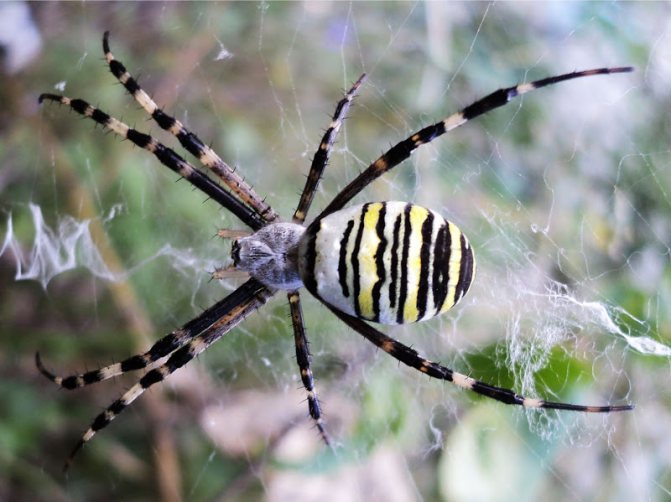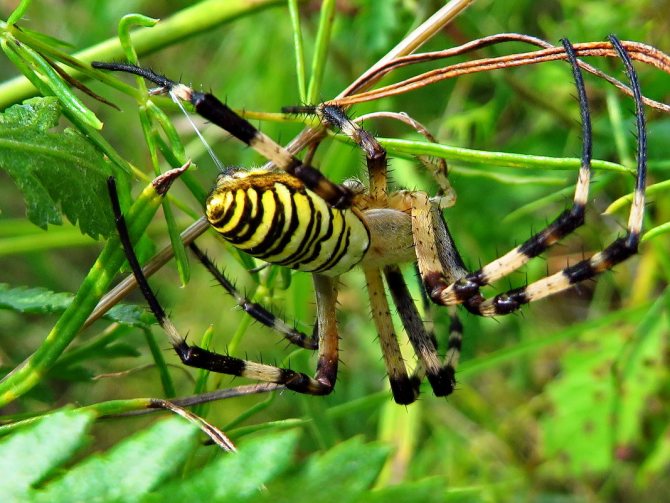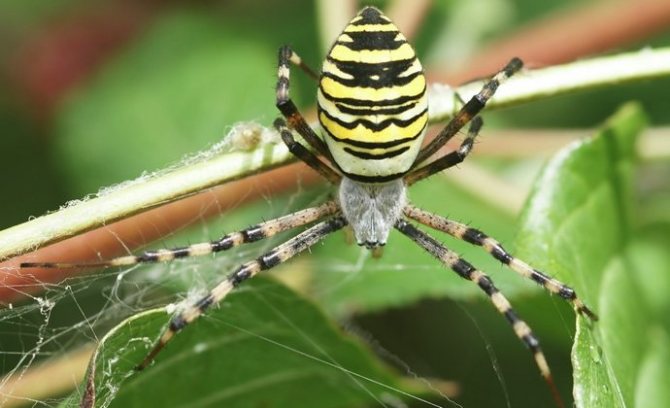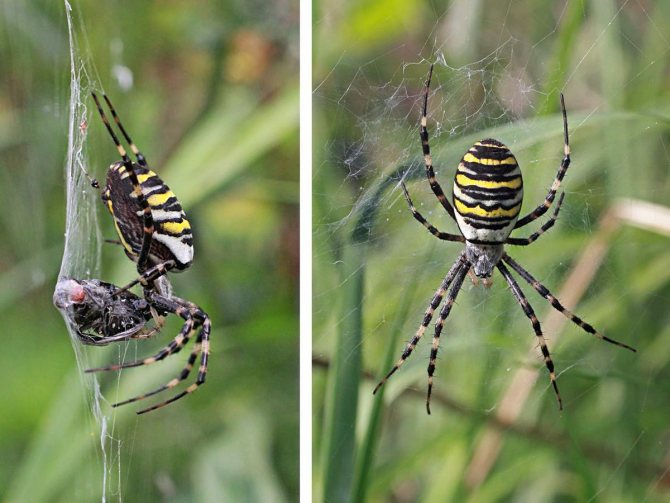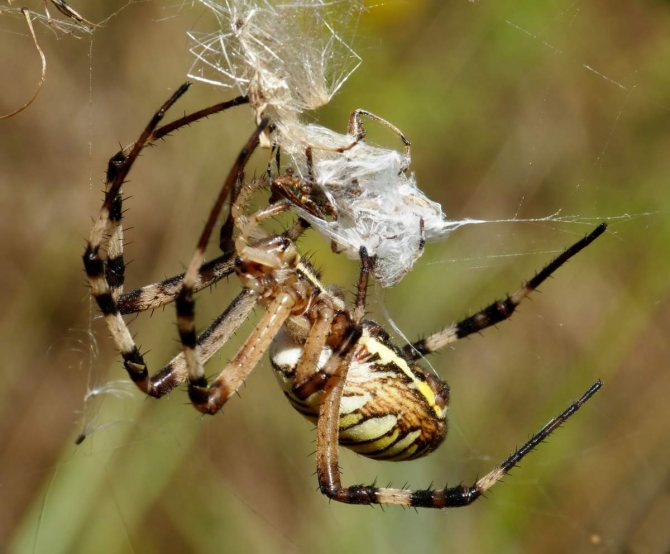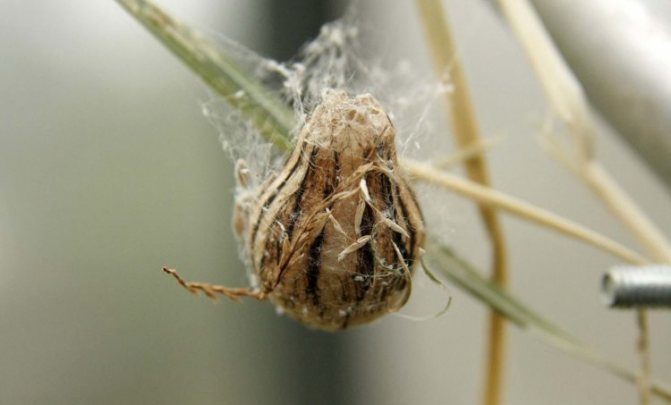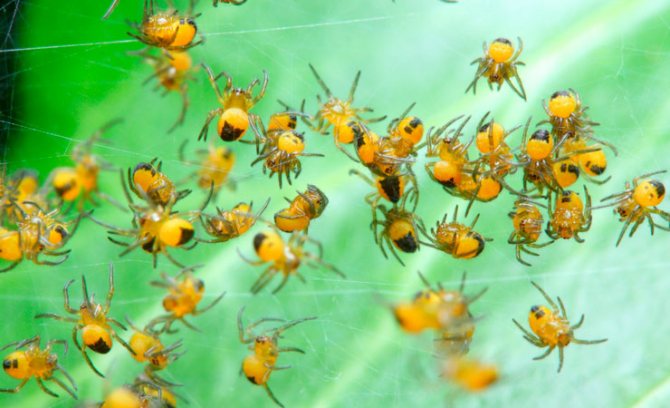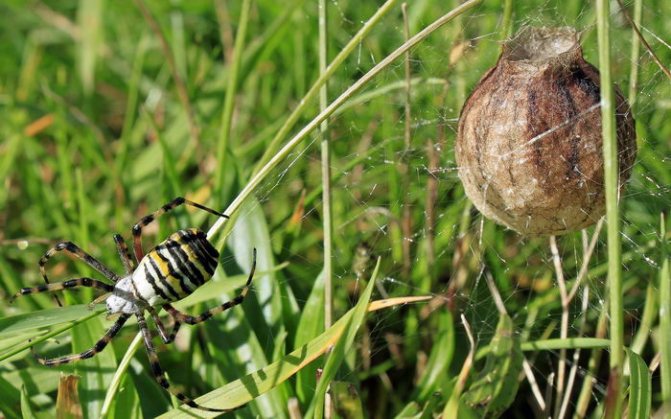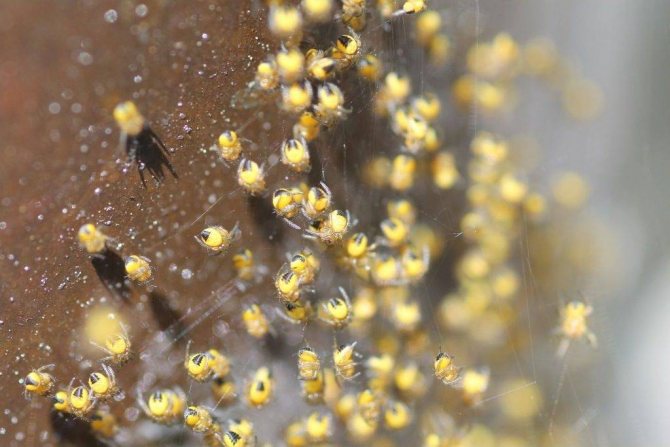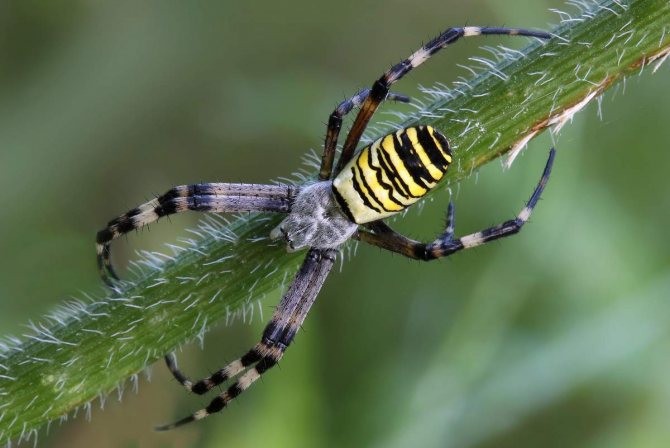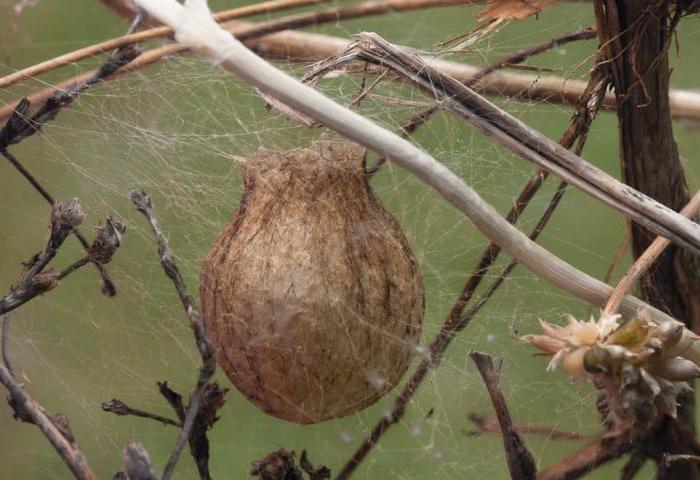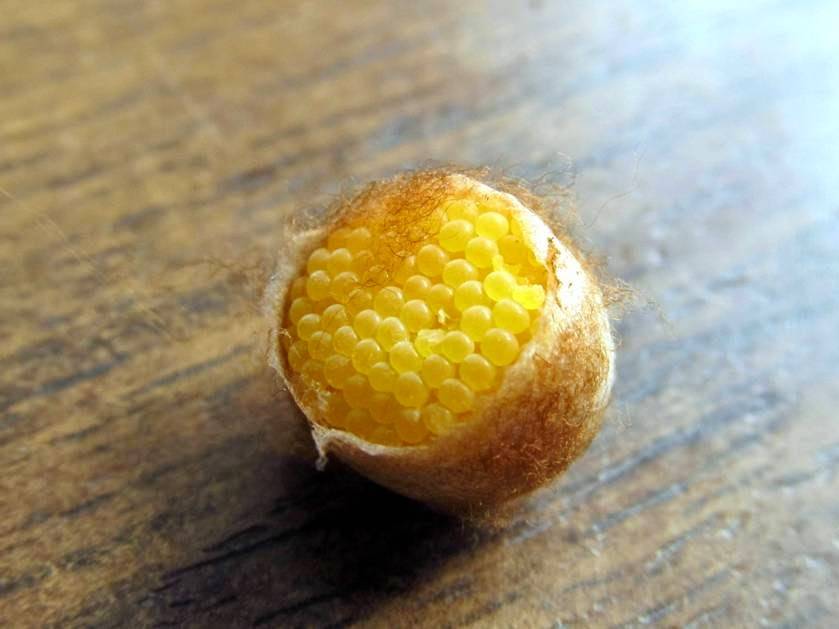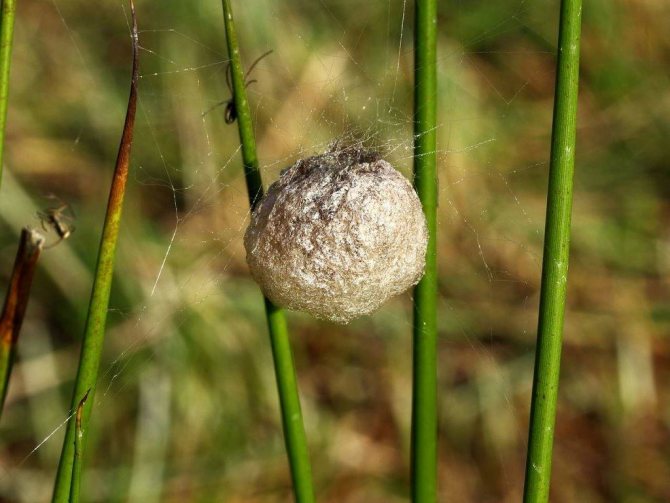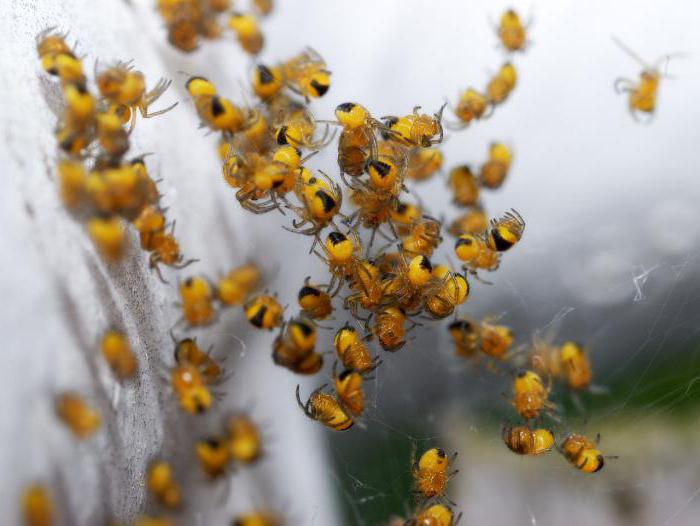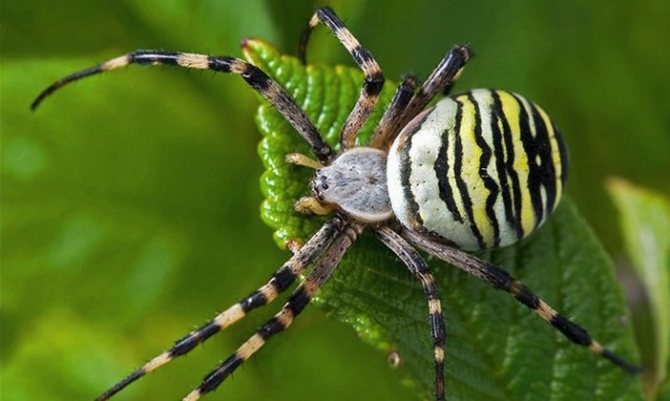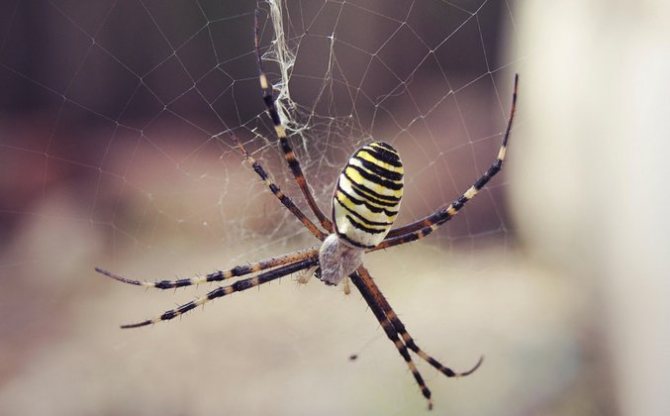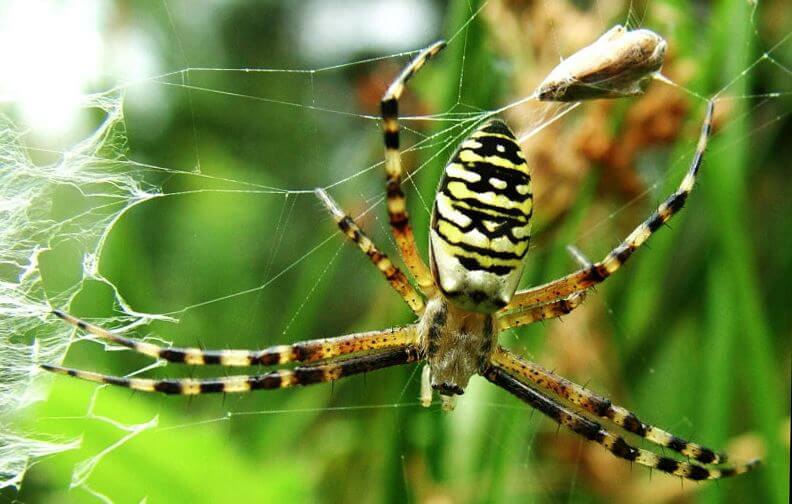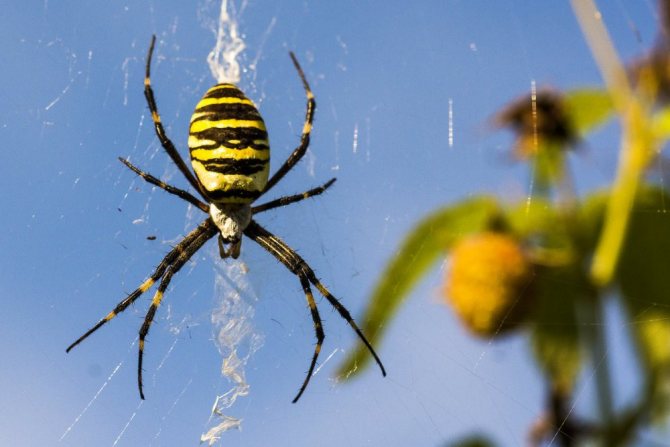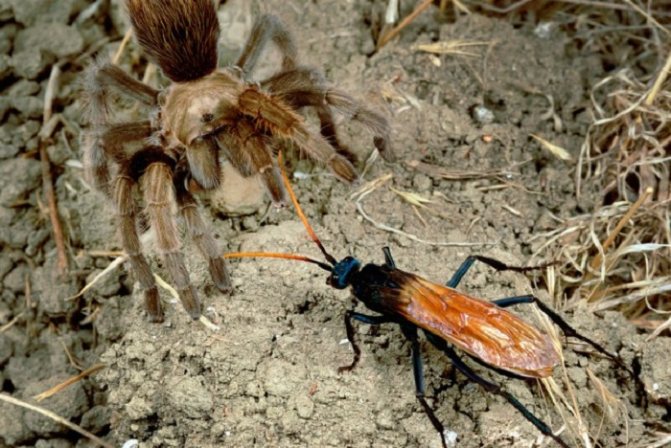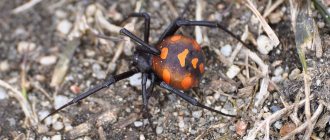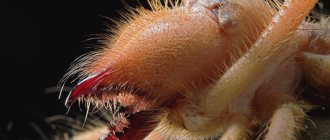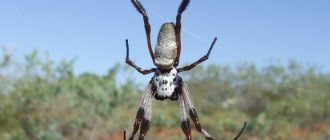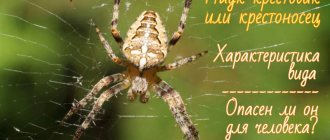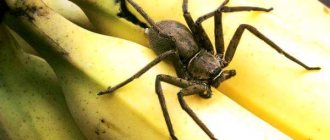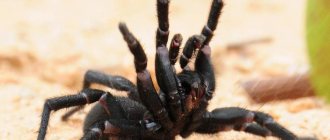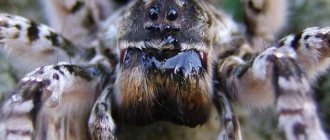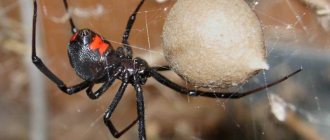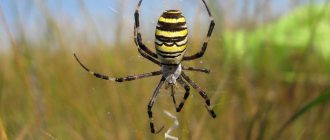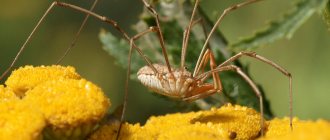The argiope bruennichi spider is an arachnid from the orb-web spider family. The people received the name wasp spider or tiger spider because of its unusual color. The frightening appearance of the individual makes many wonder if the wasp spider is poisonous or not. Zoologists are unanimous on this issue and argue that the poison of the arachnid is not dangerous for humans.
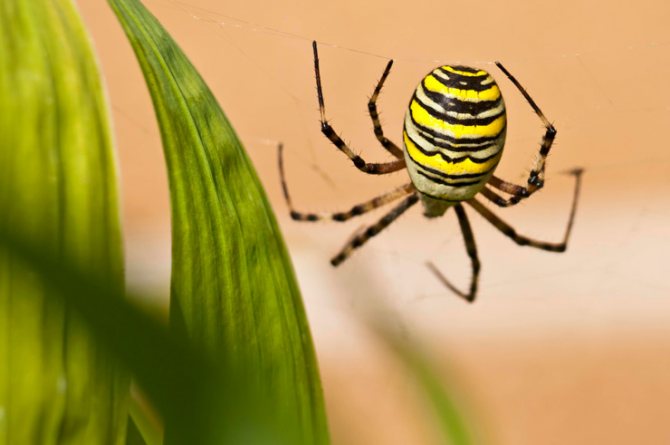
Sometimes a bright color can mislead a person about the danger of a creature, as in the case of a wasp spider
Description of appearance
Argiopa Brunnich is a typical representative of arachnids with a convex abdomen, cephalothorax. The body parts are connected by a thin bridge. The cephalothorax includes the stomach, brain, and venom glands. The body, up to 2.5 cm in size, is covered with a dense shell. Together with the legs, the size of the female wasp spider is 4 cm.
4 pairs of legs are attached to the cephalothorax. The forelimbs play the role of jaws, hold the victim during the bite, in the process of feeding. Legs are the main organ of touch and smell. There are 6 eyes on the head, but the spider's vision is weak. The wasp spider determines the approach of a victim or enemy by vibrations of the air, cobwebs.
On a note!
The color of the female is bright, catchy - the spider is yellow-black, striped. Characteristic patterns are present on the abdomen and legs. The male differs from the females in size, body shape - more elongated, and also in color. Male argiopus grows no more than 7 mm, yellow-brown color.
Tiger spider cubs are yellow with black spots at the end of the abdomen, on the legs. During the period of growing up, they molt up to 5 times, gradually increase in size, acquire a characteristic striped color. In males, the cover simply darkens. A photo of a wasp spider can be seen below. It also provides an opportunity to compare what a female, male individual looks like.
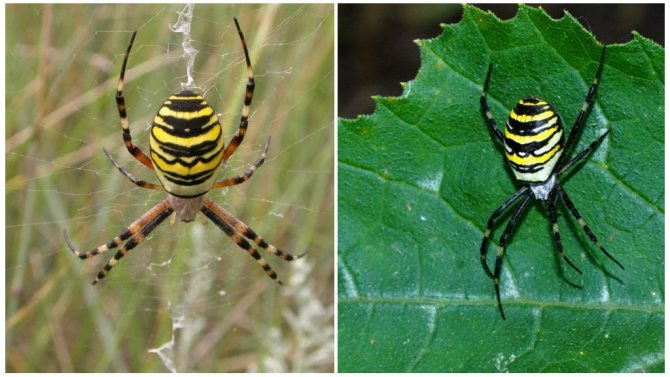

Spider-wasp or Argiope Brunnich
General information
The yellow-black spider argiope is named after the famous zoologist from Denmark Morten Brunnich. The cephalothorax and abdomen of the animal are connected by a thin septum and are very mobile. The body length of the wasp spider reaches 2.5 cm when it comes to females. Males do not exceed 1 cm in length.
A distinctive feature of this species is the clear difference between representatives of different sexes. Females are always much larger than males, their abdomen is round and oblong. In males, the body is a continuous elongated oval without clear delineations of the head and abdomen.
The arthropod got its unofficial name and comparison with known insects due to the transverse stripes on the back. The stripes are black in color and are set against a bright yellow background, which ensures the similarity. The legs of the animal are light in color and have black tips. The female always looks brighter than the male.
In this video, you will learn about the wasp spider:
You can also distinguish a male by the presence of 2-3 stripes, which are not so bright and are located on a pale yellow background. It was the females that were called the wasp spider, since the male bears little resemblance to this insect.
Habitat
The argiope spider is a fairly common species. It can be found in many countries in North and South Africa, America, Korea and China. Argiope Brunnich is found in Indonesia and Central Asia. Southern and Central Europe, Crimea, Kazakhstan are also rich in this species of arachnids.
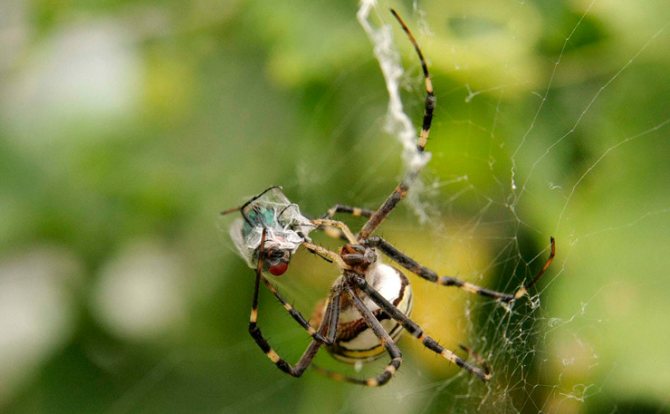

You can meet a spider in the CIS countries only in the southern regions
The arthropod is ubiquitous on the territory of Russia and the eastern part of Ukraine. He prefers a mild climate and does not tolerate cold well, therefore, in that part of our country where a humid and cold climate prevails, it is extremely rare.
The wasp spider prefers to be in the sun most of the time. That is why open meadows, lawns and places along highways become its favorite habitat. The animal prefers to place the cobweb on low plants growing in especially arid areas.
An interesting feature of the striped animal is that, thanks to its long and strong web, it can move quite long distances and easily adapt to new conditions. Quite often, southern varieties can be found in areas with colder climates.
Lifestyle features
The black and yellow arthropod does not like loneliness, therefore it settles with its close relatives in groups of 15-20 individuals. This helps them hunt for prey and raise offspring together. After the main female in the flock chooses a place for settlement, weaving of a web begins to catch insects.
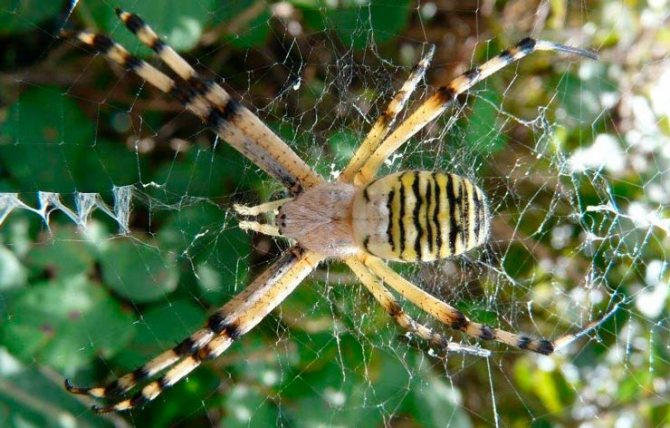

The essence of hunting a wasp spider is waiting for the prey to hit the web
Each representative of the pack weaves an extensive web, which is distinguished by its strength and beautiful pattern, in about 60 minutes. Its peculiarity is that even the smallest hole will not let the prey that has already fallen into the net.
The web is also distinguished by a variety of patterns and layering. According to research, individuals weave it in several layers so that it reflects ultraviolet rays. The glitter attracts insects of different species, providing the colony with a constant supply of food. Weaving usually begins at sunset.
If this process is interrupted, the arthropod abandons its work, hurries to shelter and, after the disappearance of the threat, begins weaving in another place. After the end of the work, the animal is placed in the center of its weaving and waits for prey, remaining motionless for several hours.
Wasp spider food
The striped spider prefers to feed on grasshoppers, various types of locusts, and mosquitoes, flies and other common insects are also included in its diet. They fall into the net, after which the animal begins the ritual of eating, which is almost indistinguishable from the feeding habits of other spiders:
- When caught in the nets, the insect tries to free itself.
- To prevent the prey from breaking the nets, the argiope bites it. When bitten, the poison and digestive enzymes of the arthropod get inside the insect.
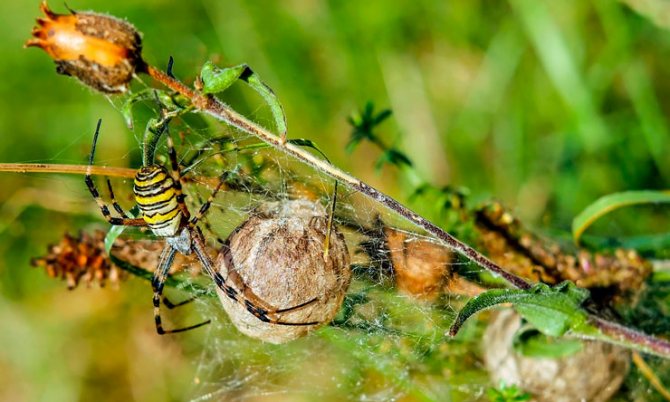

The introduction of enzymes into the victim's body activates the process of digestion of the viscera inside her - The poison immobilizes the victim, and she stops trying to free herself.
- Next, Brunnich's argiope waits for some time until the enzymes make the food fit for consumption. They actually dissolve the insides of the insect, and after a certain period of time the wasp spider simply drinks the liquid, leaving a chitinous membrane.
It is worth noting that the peculiar and multi-layered pattern of the cobweb allows the arthropod not to remain without food, since it attracts a large number of various insects during the day. As a rule, after several insects have become entangled in the web, the animal leaves this place and weaves a new one. This allows you not to scare off potential victims from beautiful networks.
Photo and description of the web
Argiopus with a yellow belly weaves a complex web, which consists of vertical, horizontal threads. A spider sits in the center, waiting for the victim. The predator is engaged in making trapping nets at night. It takes no more than an hour. A cobweb is placed between plants at a height of no more than 30 cm from the surface of the earth.
Interesting!
The cobweb shimmers in the sun, attracting the attention of grasshoppers, locusts, flies, and other insects. Argiope nets serve to scare off enemies. The big spider starts shaking the web. The vibrations increase the glare from the sun's rays, which confuses enemies.
Home content
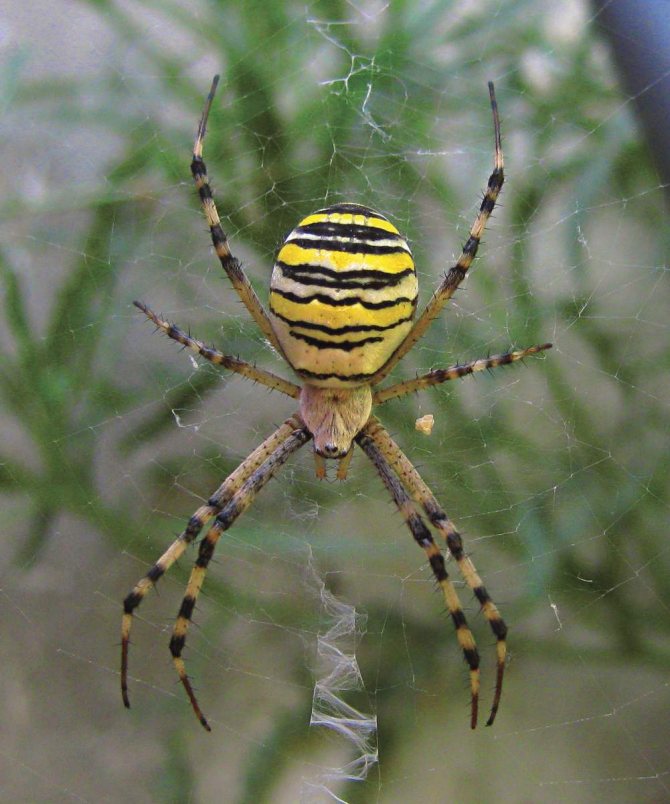

For lovers of arachnids, information on the rules for keeping such a spider as argiope brunnich at home will be useful.
As an optimal home for the bryunnyha argiopa, you will need a terrarium large enough for the wasp spider to turn around. The optimal size will be 20x30 centimeters and a height of about 20 centimeters.
It is better to choose a lid of such a terrarium with a mesh, so that a sufficient amount of air can freely flow inside.
Inside the terrarium, dry grape branches should be placed at different angles and different sizes so that the spider is comfortable doing the weaving of a web, which is familiar to itself.
He will arrange secluded places in the corners of the terrarium, where he will hide excess prey. It is advisable to maintain room temperature and sufficient humidity inside the enclosure.
Important! It is recommended to spray the entire terrarium with water from a spray bottle only in the summer, when the outside air temperature exceeds 30 degrees. Excessive moisture can contribute to the development of mold and mildew, which will lead to the death of the spider.
Where dwells
The bee-like wasp spider is found all over the world. The ideal conditions are humid air, high temperatures, and long summers. The female lives for 1 year, the male dies much earlier. Argiopes live on almost all continents. For the settlement, they choose a sunny meadow in the forest, on the edge, meadows, fields. They often settle in gardens, orchards.
The zebra spider sits motionless on its web in the very center, legs spread out with the letter "X". If necessary, it develops new territories at night, moving through the air on its own spider web.
Habitat
The argiope species Brunnich is widespread in Central and Southern Europe, North Africa, Kazakhstan, Asia Minor and Central Asia, India, Japan, Korea and China, in the Caucasus. The northern border of habitation in Russia, according to data at the beginning of the 70s of the last century, reached 52-53º C. sh. Since 2003, reports began to arrive that argiopa was found much north of this line.
In Russia, this type of spider can be found in the Oryol, Bryansk, Lipetsk, Belgorod, Penza, Voronezh, Ulyanovsk, Tambov, Saratov, Ryazan, Tula, Moscow and Chelyabinsk regions. In 2020, argiopa was found in the Rdeysky nature reserve (Novgorod region). Active dispersal is facilitated by an unusual way of movement of young individuals - downwind.
There is a tendency of Brunnich argiopa to xerophilous vegetation. Spiders prefer dry air and cannot tolerate high humidity. They settle, as a rule, on herbaceous plants and shrubs located in meadows, roadsides, forest edges and other open sunny areas.
Food
A yellow striped spider, similar to a wasp, eats insects that fall into its trapping nets. The main diet is grasshoppers, crickets, locusts, flies. The victim gets entangled in the web in a few seconds. Argiop senses the vibrations of the threads, makes his way to the prey. Bites, injects poison, paralyzes an insect. Then he injects saliva, which liquefies the insides of the victim, envelops the cobweb, leaves for a while. It sucks out all the juices, leaving a chitinous cover.
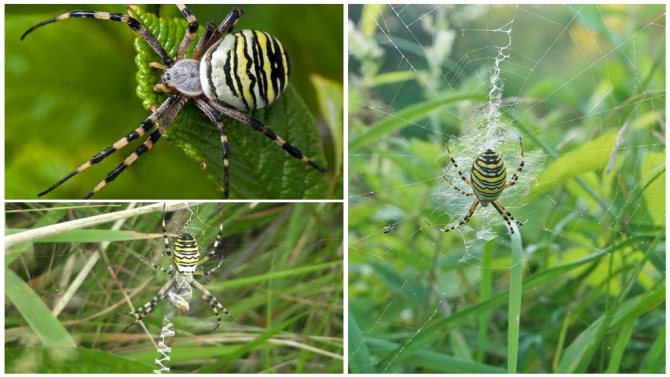

Spider-wasp or Argiope Brunnich
Interesting!
A spider like a wasp is not of interest to birds, large insects, and other arachnids. He has practically no natural enemies. Argiop frightens off with its appearance - stripes on the back.For males, the main enemy is the female. She devours him immediately after fertilization.
Characteristics of Brunnich's argiopa
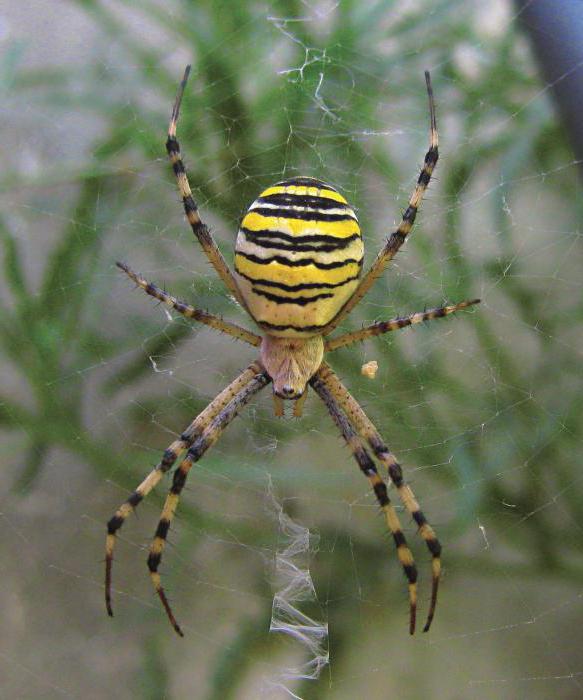

Argiopa is a small spider. The body length of females reaches 1.5 cm, males are much smaller - up to 0.5 cm. In adults, pronounced sexual dimorphism is observed. Females have a bright color. They have an oblong-rounded abdomen. On the back of females, there is a pattern in the form of a series of black stripes on a bright yellow background. This gives them an external resemblance to a wasp, which is the reason for the second name. The cephalothorax is silvery, with thin and long legs of light color with wide black rings. Males are almost three times smaller than females, inconspicuous and inconspicuous: the abdomen is narrow, pale beige in color with two dark stripes. The legs are long and slender with dark, diffuse rings. On the second pair of limbs (pedipalps), bulbs (male genitals) are noticeably pronounced.
In the photo below - a female and a male.
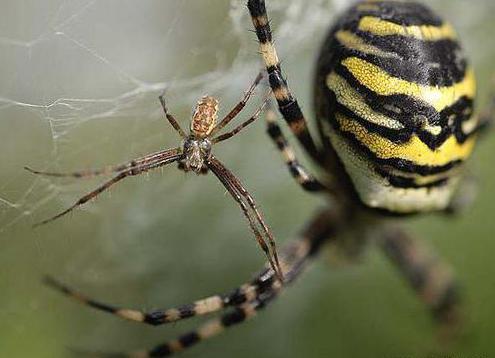

Reproduction
A tiger spider with a wasp coloring gives only one generation of cubs over the summer, in tropical countries there may be more. A female with a yellow bottom lays up to 600 eggs at a time. Initially, weaves a cocoon from a web, places it inside the egg. Places the pouch near its trapping nets.
After 2 weeks, a large generation of spiders appears, which crawl in different directions. Before reaching puberty, they have to go through 5 molts. Each time a young argiopus grows in size, acquires a characteristic color.
Features and behavior
The spider has a bright brindle color. Size - seven to eight centimeters with a paw span of up to 22 centimeters. Habitat - the territory of India and Sri Lanka. They live in both rural and urban areas.
They prefer to hide in shelters: holes or holes in tree trunks, under bark, in the walls of houses. Burrows have many entrances and exits. Inside the shelter is lined with cobwebs. They live in groups. These spiders do not use cobwebs for hunting. They can hunt collectively, but during the hunger period they eat smaller brothers. They feed on insects, small lizards, and other spiders. They have sensitive tactile bristles on their legs. They pick up vibrations from nearby animals. They attack from ambush with a swift leap. Paralyze the victim with poison, the poison is very strong. They are able to move very quickly and jump long distances.
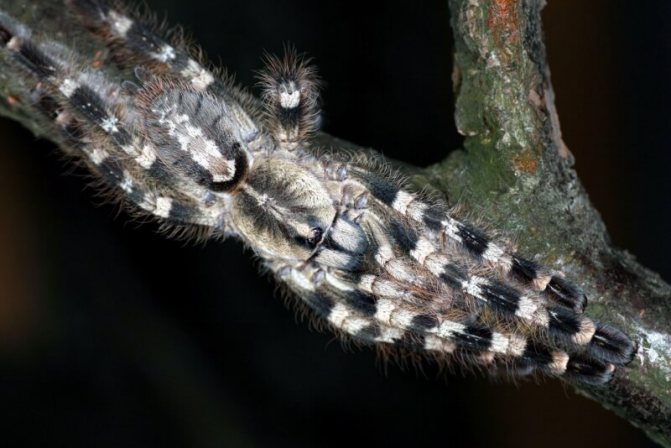

It can be aggressive towards people, but does not attack first. Attacks only when defending, when there is no cover nearby to hide.
Sexual maturity is reached by the age of two. Mating occurs frequently, after mating the female can be very aggressive. Eggs are laid in a burrow in a cocoon. One clutch can contain from 100 to 250 eggs. Little spiders hatch after two months. Young spiders dig holes in the soil and hide there at the slightest danger.
The difference between the female and the male in color: the female is brighter. In addition, females and males differ in the proportions of legs and body. The lifespan of females is fifteen years, of males - about twelve years.
Wasp spider is poisonous or not
An arthropod possesses poisonous glands in which a toxic substance is produced. When the victim enters the body, it causes muscle spasm, immobilization. The poisonous bryunnich is not distinguished by an aggressive disposition, does not attack unnecessarily. For a person, her presence nearby does not pose a danger. However, if the argiop feels its own life threatened, an attack and a spider bite will follow.
On a note!
What is the danger of a spider bite with a wasp color - a local reaction on the skin. There is swelling, redness, pain. Young children, people with weakened immune systems are more difficult to tolerate attacks of argiope. If you are prone to allergies, breathing difficulties may occur. In most cases, the symptomatology disappears on its own and does not require special treatment.
Due to its unusual color, the wasp spider is kept at home as pets.They live in specially equipped aquariums and feed on insects. You should feed every other day. Spiders live in an apartment for up to 1.5 years.
Danger to humans
According to scientists, the poison secreted by a spider when bitten cannot harm a person. It acts as a defense mechanism and is dangerous only for insects, which are hunted by the argiope Brunnich.
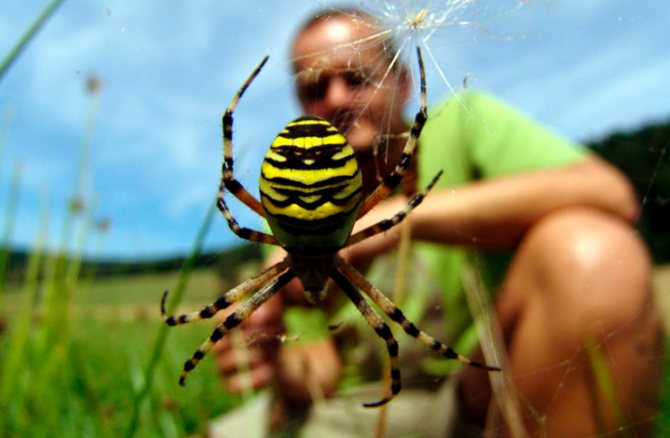

The bite of this spider is not dangerous for life, but it causes prolonged pain.
But this does not mean that the arthropod will not bite a person who intentionally or accidentally tries to pick it up and crawl into the web. The bite is comparable to that of a wasp in terms of the nature of pain due to the strong jaws of the arachnid and the ingestion of poison under the human skin. In most cases, the pain goes away after 1 to 2 hours.
A hyperemic spot and swelling may form at the site of the bite. The body's response depends on the predisposition to an allergic reaction and the state of the immune system. Such bites are especially dangerous for people who are allergic to insect venom., as well as for small children with fragile immunity.
A spider cannot cause death of a person, but if there is severe itching, burning, swelling and hyperemia at the site of the bite, it is recommended to consult a specialist. This is especially necessary if dizziness, weakness, nausea, or a critical decrease in blood pressure join the symptoms.
Argiope Brunnich - arachnid with a unique color and lifestyle. If you keep at a distance from its nets and do not try to harm, the spider is not dangerous to human life and health.
It is interesting: what are the spiders.
What is the argiope spider?
Due to its color, the argiope spider bears names such as:
However, its biological name is "Argiope Brunnich", which the spider received in honor of a Dane named Morten Trane Brunnich, who lived in the eighteenth and early nineteenth centuries and was at one time a very famous scientist in the field of zoology and mineralogy.
First, let's take a look at what argiopa looks like in the photo.
The benefits and harms of a spider
As we have already said, this spider almost does not bring harm to humans. If you yourself do not offend him. It is just clogging up open places with its cobwebs, a little interfering with a carefree walk. But this is not harm, but a slight inconvenience.
But the benefits of it are great. He can catch up to 400 harmful insects in his nets per day. Therefore, do not rush to destroy them if you see them in a meadow or on a forest edge. In the forest, in the garden or in the vegetable garden, these tireless orb-webs weave their nets and catch springtails, leaf rollers, bugs, aphids, caterpillars, mosquitoes, flies and other harmful insects in them.
Spiders are gluttonous, they eat as much in a day as they weigh themselves. So calculate how much this ecological insect trap can do over the summer. In addition, according to ancient Eastern philosophy, the spider brings good luck.
Life cycle features
The life span of large spiders with yellow stripes is 1 year. Puberty occurs in the second half of summer, July - August is the time for mating and laying of eggs.
The fertilized female kills and eats the male, and after a few days begins to weave a cocoon to lay eggs. The larger the argiope, the more offspring it produces - the clutches of some specimens reach 400 eggs.
The spider is a caring mother. She weaves a reliable fluffy cocoon, hangs it up in a secluded place, and protects it. Argiope dies before the juveniles appear.
Young (juvenile) spiders hatch in autumn. In cold climates, they remain under the protection of a cocoon until spring, then settle and mature quickly.
Interesting! Did you know that "Indian summer" is the period of settlement of juvenile spiders. The crumb crawls out of their cocoon, climbs a hill and throws out a cobweb.An arthropod caught by the wind rushes towards independent life. It is so small that we can only see a weightless snare circling in the air.
The nature and lifestyle of the agriopa
Representatives of the species argiopa bryunnich
usually gather in few colonies (no more than 20 individuals), lead a terrestrial life. The net is fixed between several stalks or blades of grass.
In the photo, the spider argiope brunnich
Argiope
—
spider
orb weaving. Its nets are distinguished by a very beautiful, even pattern and small cells. Having located its trap, the spider nestles comfortably in its lower part and patiently waits for the prey itself to come to its possession.
If he senses danger, he will immediately leave the trap and descend to the ground. There, the argiope is located upside down, hiding the cephalothorax if possible. However, in some cases, the spider may try to ward off the danger by starting to swing the web. Thick filaments of stabilamentum reflect light, which merges into a bright spot of unknown origin to the enemy.
Argiopa has a calm character, seeing this spider in the wild, you can see it at a fairly close distance and take a picture, it is not afraid of humans. During the morning and evening twilight, as well as at night, when it is cool outside, the spider becomes lethargic and inactive.
What does the yellow spider eat?
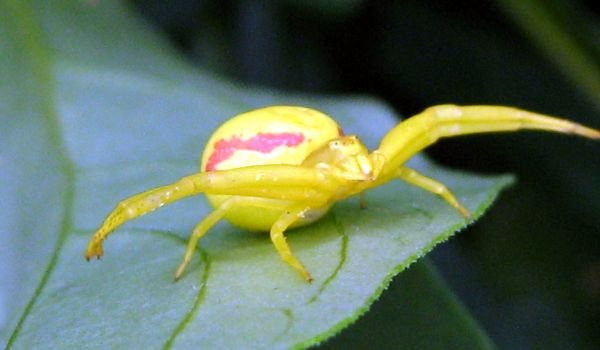

Photo: Poisonous yellow spider
The diet of the yellow spider does not differ in a wide variety and consists almost entirely of insects.
It:
- bees;
- butterflies;
- beetles;
- hoverflies;
- wasps.
All of these are pollinators. This is due to the hunting method most convenient for the yellow spider: it waits for prey right on the flower, hiding and merging with the background. Most often they choose goldenrod and yarrow, but if they are absent, they can choose others.
It is in anticipation of prey that they spend most of them, without moving, so as not to frighten it off. Even when she sits on a flower, the yellow spider continues to wait until she plunges into it and starts sucking the nectar, and only after this process absorbs the attention of the victim does it attack.
Namely: it grabs with strong front legs to prevent it from leaving or doing something else, and bites - its poison is very strong, and it paralyzes even a large insect almost instantly, and soon it dies. This method of hunting allows the spider to kill even larger and stronger insects than itself: its two main weapons are surprise and poison.
If the hunt is unsuccessful, then the same wasp is quite capable of dealing with the yellow spider, because it is more agile, moreover, it can fly: in front of it, its abdomen will be completely defenseless. Therefore, the yellow spider has to attack for sure and perfectly calculate the moment - otherwise it will not live long.
When the victim dies, he injects digestive juices into her, turning her tissues into a soft gruel, easy to digest, and eats this gruel. Since the victim may be larger than the spider, it often eats only part at a time, storing the rest for the future. Devours everything except the chitinous shell.

